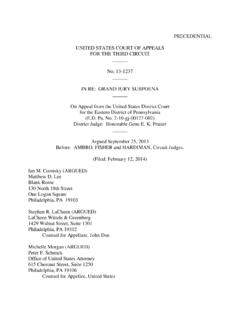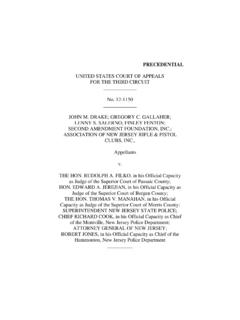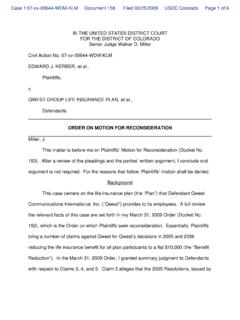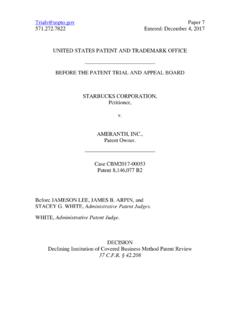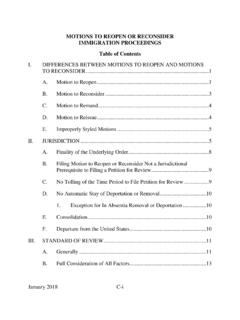Transcription of Question Q209 National Group: United States Title ...
1 Question Q209. National Group: United States Title : Selection Inventions the inventive step Requirement, other patentability criteria and Scope of Protection Contributors: John Osha Chair William Ellis Co-Chair Rick Neifeld Janet MacLeod Drew Meunier Jeffrey Bergman David Chernek Leslie MacDonell Gau Bodepudi Datum: February 16, 2009. SUMMARY: law does not denominate selection inventions as a distinct category of invention. Selection inventions are considered by the United States Patent and Trademark Office ( USPTO ) and the United States Federal Courts under the same criteria (statutory subject matter, written description, enablement, best mode, novelty, and non-obviousness) as any other invention. However, a significant body of case law has evolved to determine how these criteria are applied to selection inventions. Most importantly to this topic, the recent Supreme Court decision in KSR Int'l Co. v. Teleflex Inc.
2 , 550 398 (2007) ( KSR ). changed the required analysis for determining obviousness and made it more difficult to patent selection inventions (and other types of inventions) even where the prior art does not explicitly teach the advantageous properties of the claimed selection. Because of the recent nature of the KSR decision, guidance from the Federal Courts on precisely how KSR affects patentability of selection inventions is limited as of this date. Novelty and non-obviousness are considered in the context of the degree of predictability of the subject matter area being claimed. Thus, in general, it is more difficult to obtain a patent to a selection invention in a predictable art area ( , mechanics, electronics) than in an un-predictable art area ( , chemistry, biotechnology). Unlike many other jurisdictions, the law does not require evidence of advantageous properties of a selection invention to be presented in the application as filed.
3 Rather, such evidence is permitted to be submitted in the form of a declaration after the application is filed. The evidence may be, for example, test data prepared after the date of filing the application, comparing the claimed selection or species to a genus or distinct species identified in the prior art by the USPTO examiner. In the infringement context, infringement is determined based upon the language of the claims without a per se limitation to any advantageous property relied upon to distinguish the prior art. Of course, if the advantageous property or, for example, a new use of a known compound is recited directly in the claim, then such property or use is a limitation for purposes of determining infringement. Further, any arguments made or evidence presented to distinguish the prior art may be relevant to claim construction (determining the proper meaning and scope of the claim) and to analysis of infringement under the Doctrine of Equivalents.
4 QUESTIONS: GENERAL. Groups are asked to give a summary of the legal position as regards a patent for a purported selection invention in their jurisdiction in relation to the following: Q1. Legal developments on selection inventions Question What specific types of inventions are recognized under the concept of selection invention and are patentable in your jurisdiction? Response Answering directly, any selection invention claimed in an application meeting the requirements for patentability under law is patentable. statutory law does not refer expressly to selection inventions, but rather provides that any new and useful process, machine, manufacture, or composition of matter, or any new and useful improvement thereof, may be patented, subject to additional requirements . 35 USC 101. Thus, any selection invention defining a useful process, machine, manufacture, or composition of matter may be patentable in the United States if it meets the other substantive requirements : novelty (lack of anticipation), non-obviousness, written description, enablement, and best mode.
5 35 USC 102, 103, 112. Novelty, non-obviousness, and sufficiency of description under law are addressed in responses to other questions. Recent legal developments in the United States impact the patentability of selection inventions. The Supreme Court case KSR Int'l Co. v. Teleflex Inc., 550 398. (2007), unquestionably made it more difficult to establish the non-obviousness of any invention, including selection inventions. While KSR dealt with a mechanical invention, it reset the standard for obviousness determinations for all inventions. Under KSR, an examiner or a court may go beyond the express teachings of references to consider the background knowledge possessed by a person having ordinary skill in the art . and the inferences and creative steps a person of ordinary skill in the art would employ in determining if the selection would have been obvious. Id. at 1740-41. Thus, KSR relaxed a former strict requirement for proof relating to inferences.
6 KSR also States that the success of one of a finite number of identified, predictable solutions, .. is likely the product not of innovation but of ordinary skill and common sense, . and if so, is not patentable. Id. at 1742. The foregoing passage limits the probative value of the number of elements in a genus in determining obviousness of selected species. KSR also allows a claim to be held obvious based upon an obvious to try standard, stating that the lower court conclude[d], in error, that a patent claim cannot be proved obvious merely by showing that the combination of elements was obvious to try.' Id. This statement in KSR was not specific to the mechanical invention at issue. In fact, the Board of Patent Appeals and Interferences ( the Board ) of the Patent and Trademark Office ( USPTO ). latched onto this statement in a rare precedential decision in a biotechnology case, Ex parte Kubin, stating that obvious to try' may be an appropriate test in more situations than we previously contemplated.
7 83 1410. The Board's decision in Ex parte Kubin was appealed to the Court of Appeals for the Federal Circuit ( the Federal Circuit ), the appellate court with exclusive jurisdiction over patent matters in the United States . The Federal Circuit heard oral arguments in January 2009 and is expected to render its decision sometime this year. That said, selection invention patents continue to issue from the USPTO, typically in the areas of chemistry, pharmaceuticals, and biotechnology. This is primarily because these technological areas are recognized by the courts as unpredictable art fields. See Eisai Co. v. Dr. Reddy's Labs, Ltd., 533 1353, 1359 (Fed. Cir. 2008) ( To the extent an art is unpredictable, as the chemical arts often are, KSR's focus on these identified, predictable solutions' may present a difficult hurdle because potential solutions are less likely to be genuinely predictable. ). Post KSR, the obviousness determination still requires two distinct elements: (1) motivation.
8 And (2) reasonable expectation of success. Takeda Chem. Indus., Ltd. v. Alphapharm Pty., Ltd., 492 1350, 1360 (Fed. Cir. 2007). Failure to proffer sufficient proof of either element leads to a conclusion of non-obviousness. Id. (finding no prima facie obviousness because defendant could not show either motivation to select the inventors' chosen starting compound or any expectation that the inventors' chosen modifications would succeed). In the unpredictable fields of chemistry and biology, it is easy to see the logic and effectiveness of an argument for patentability premised on a lack of reasonable expectation of success. Accordingly, many, though certainly not all, selection invention patents issue because the prior art does not provide a basis for one skilled in the art to reasonably expect success in obtaining the invention as claimed. Question Do you have any examples of selection inventions in a field other than chemical, pharmaceutical, or material science fields?
9 Response After KSR, it is less likely for a selection invention in the more predictable art fields to be found patentable. However, a recent opinion of the Federal Circuit explained that, while KSR cautioned us to not be too rigid , we may still consider evidence of teachings to combine (and, presumably, not to combine) because, according to the Supreme Court, they capture[] a helpful insight' into the obviousness inquiry. Anderson Corp. V. Pella Corp., No. 2007-1536, 2008 SL 4927431, at *6 (Fed. Cir. Nov. 19, 2008). Presumably, a teaching not to combine a selected element of a disclosed list of elements, would enable a claim to that selected element to be found non-obvious and therefore patentable. Q2: Novelty Question Groups are asked to discuss any issues that should be considered with respect to the novelty of selection inventions. For example, is merely carving a range out of a broad prior art disclosure sufficient to make a selection invention novel?
10 Is a different advantage or use, or the same advantage with an unpredictable improvement required for a selection invention to be novel? Response I. CLAIMS TO COMPOUNDS. In United States Patent Law, it is well established that the disclosure of a genus in the prior art is not necessarily a disclosure of every species that is a member of that genus. In fact, there may be many species encompassed within a genus that are not disclosed by a mere disclosure of a genus. However, there are cases in which prior disclosure of a genus class anticipates a claimed species within that genus. To determine whether a prior-disclosed genus class anticipates a claimed species, a case-by-case analysis needs to be conducted. Although there is no clear-cut answer, there are a number of factors that are typically taken into account when determining whether a prior-disclosed genus class anticipates a claimed species within that genus.

